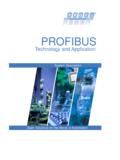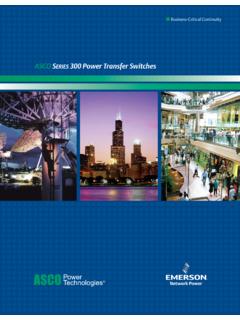Transcription of Dual Connectivity for LTE-NR Cellular Networks
1 XXXV SIMP OSIO BRASILEIRO DE TELECOMUNICAC OES E PROCESSAMENTO DE SINAIS - SBrT2017, 3-6 DE SETEMBRO DE 2017, S AO PEDRO, SPDual Connectivity for LTE-NR Cellular NetworksRoberto P. Antonioli, Gabriela C. Parente, Carlos F. M. e Silva,Emanuel B. Rodrigues, Tarcisio F. Maciel, Fco. Rodrigo P. CavalcantiAbstract The dual Connectivity (DC) technology has gaineda lot of momentum in the LTE Release 12 as a means to enhancethe per-user throughput and provide mobility robustness. Somestudies in the literature have discussed a coupling between theLTE and the air interface of the upcoming Fifth Generation (5G)in a DC scenario. That integration may provide some benefits tomeet the high throughput demands, reliability and availabilityrequirements of the 5G Networks .
2 This paper presents a briefoverview of the DC technology considering the inter-generationscoupling and discusses some challenges involving Radio ResourceManagement (RRM) in such 5G, dual Connectivity , Multiple Radio AccessTechnologies, Radio Resource INTRODUCTIONDue to the steep increase in mobile traffic over the pastyears, there have been many attempts in finding new commu-nication technologies to further improve the end-user experi-ence and system performance of mobile Networks . The trafficgrowth has been mainly driven by the explosion in the numberof connected devices, which are demanding more and morehigh-quality content that requires very high throughput resulted in a 4000-fold growth in mobile traffic over thepast 10 years [1].
3 As a consequence, industry and academyhave triggered investigations to develop new technologies tomeet the forecasted capacity of the most promising alternatives to achieve the ultra-high per-user throughput demands is to increase the celldensification by deploying small cells (known as pico cellsand femto cells) [2], which have smaller coverage region andlower transmission power if compared to traditional macrocells (deployments and requirements for small cells can befound in [3]). In these Heterogeneous Networks (HetNets), themacro cells are responsible for providing a wide and reliablecoverage region, while the small cells can offer improvedcapacity in hotspot areas and offload some traffic from themacro cell [4].
4 However, the deployment of small cells has thedisadvantage that due to the smaller cell coverage area and thelarger number of cell boundaries, mobility-related issues mayarise, such as an increase in the number of cell (re)selectionsand this context, the dual Connectivity (DC) technology hasbeen proposed in the Long Term Evolution (LTE) Release 12specifications by 3rd Generation Partnership Project (3 GPP)as one of the most relevant technologies to accomplish evenhigher per-user throughput and mobility robustness, and loadbalancing [5]. Given that a User Equipment (UE) is configuredwith DC, it can be connected simultaneously to two EvolvedWireless Telecommunications Research Group (GTEL), Federal Universityof Cear a (UFC), Fortaleza - CE, Brazil, E-mails:{antonioli, gabriela, cfms,emanuel, maciel, 1.}
5 Example of deployment scenario of DC composed of one MeNB andtwo SeNBs. Notice that the UE-1 and UE-2 are in single connection with theMeNB and SeNB-2, respectively, while UE-3 is in DC with the SeNB-1 Bs (eNBs): a Master eNB (MeNB) and a Secondary eNB(SeNB), which operate on different carrier frequencies andare interconnected by traditional backhaul links (known as X2interface in accordance with the LTE terminology). These X2-based backhauls are non-ideal in practice, being characterizedby a certain latency and limited capacity [3].In Fig. 1, an example of a DC scenario is illustrated, whichis composed of a MeNB connected to two SeNBs via non-ideal backhaul links and three UEs. UE-1 and UE-2 are insingle connection with MeNB and SeNB-2, respectively, whilethe UE-3 is in DC with the SeNB-1 and MeNB.
6 Therefore,the throughput of UE-3 would be increased by utilizing radioresources from different from the DC scenario presented in [2] and [5],where a HetNet composed of LTE eNBs operating on differentfrequencies was considered, another possible solution for DCthat has been exploited in the literature is a scenario withthe integration between multiple Radio Access Technologies(RATs), where the MeNB belongs to one RAT and the SeNBto another. In this context, some works have considered asa possible solution for DC a tight integration between theupcoming Fifth Generation (5G) RAT, named as New Radio(NR), and the legacy Fourth Generation (4G) RAT, namelyLTE [6], [7].
7 More specifically, this integration would be performed byproviding a larger coverage region, supplied by the legacyLTE MeNB, to the SeNBs using the NR technology [7],[8]. Therefore, for simplicity, in the remaining of this pa-per, MeNB refers to LTE MeNB and SeNB refers to NRSeNB. The objective of this configuration is to increase thesystem reliability by diminishing the occurrence of service171 XXXV SIMP OSIO BRASILEIRO DE TELECOMUNICAC OES E PROCESSAMENTO DE SINAIS - SBrT2017, 3-6 DE SETEMBRO DE 2017, S AO PEDRO, SPinterruptions that might occur due to the intrinsic propa-gation characteristics of Millimeter Wave (mmW) used byNR (such as higher penetration loss, lower diffraction, andsignal blocking from moving objects) or because of Non-Lineof Sight (NLOS) situations when using narrow beams withmassive Multiple Input Multiple Output (MIMO).
8 Besides,this integration targets the fulfillment of the 5G requirementsby means of allowing simultaneous multi-RAT connectivityin order to provide faster mobility and Centralized/CommonRadio Resource Management (CRRM) [8].The proposed tight interworking between the LTE and NRtechnologies goes beyond the current inter-RATs cooperation,where slow procedures allow hard handover and access se-lection procedures, and are focused on coverage purposes [7].Furthermore, the LTE-NR tight integration would enable theexploration of: (i) RAT diversity, where either the best RATor simultaneously multiple RATs would be selected for estab-lishing connection, and (ii) transmission diversity, where thesame packet would be transmitted via both RATs to enhancereliability or different packets would be transmitted via thedifferent RATs to increase the per-user this multi-RAT and multi- Connectivity sce-nario, this paper presents a brief overview of the DC tech-nology considering the integration between LTE and NR anddiscusses some challenges involving Radio Resource Manage-ment (RRM) techniques in such paper is organized as follows.
9 In Section II, an overviewof the system architectures for the DC technology is presentedfollowing the 3 GPP recommendations of the Release 12 andrecent works from the literature. In Section III, the userconnectivity solutions are presented considering the new DCarchitectures. Challenges involving RRM techniques in theLTE-NR DC scenario are presented in Section IV. Finally,in Section V, the conclusions and perspectives are SYSTEMARCHITECTURES FORDUALCONNECTIVITYIn order to allow more flexible and cost-effective HetNetdeployments, a new network architecture has been proposedand attracted a lot of attention during the standardizationprocess of the LTE Release 12.
10 In this architecture, there is asplit between the Control and User Planes, where, basically,the Control Plane is responsible for transmitting system infor-mation and controlling the UE Connectivity , and the User Plane(also referred as Data Plane) handles UE specific data [4].Considering this separation, the Control and User Planes mightnot be transmitted by the same network node, which bringsimportant new features that enable the DC, as explained inmore details in the , this architecture allows network operators tobe more flexible in the network management by, for example,designing the MeNBs to handle the UE Connectivity and theSeNBs to be activated only when there is data to be transmit-ted [4], which would decrease SeNBs power User PlaneConsidering the perspective of the User Plane, after anevaluation of several possible options, two DC solutions havebeen standardized by 3 GPP.





